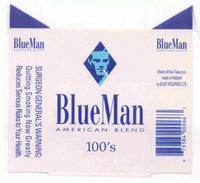Citable TTAB Decision Has Blue Man Group Seeing Red
Fame is an elusive butterfly that often leaves the pursuer blue in the face and empty-handed. So the Blue Man Group discovered in the TTAB's seventh citable decision of the year. In a 37-page opinion, the Board dismissed the group's opposition to registration of the mark BLUEMAN for tobacco and cigarettes, finding the mark not likely to cause confusion with the BLUE MAN GROUP mark, registered for musical and theatrical performances, musical recordings, magnets, postcards, posters, hats, T-shirts, and sweatshirts. The Board also rejected Opposer's dilution claim because the group failed to prove its mark famous for dilution purposes. Blue Man Productions, Inc. v. Tarmann, 75 USPQ2d 1811 (TTAB 2005).

Applicant Erich Tarmann successfully employed the old "rope-a-dope" strategy: he did not submit testimony or any other evidence, nor did he file a brief. The Blue Man Group's case, however, lacked any wallop: the group did not submit narrative testimony, relying instead on a batch of “printed publications” and recorded broadcasts. It claimed its mark to be famous, but it failed to back up that assertion with any sales or advertising figures. The Board found Opposer'’s evidence inadequate to support the fame claim:
"In view of the extreme deference that is accorded to a famous mark in terms of the wide latitude of protection that it receives, and the dominant role that fame plays in the likelihood of confusion analysis, we think that it is the duty of a plaintiff asserting that its mark is famous to clearly prove it. Although opposer has shown that its mark has achieved some recognition for musical/comedy/theatrical performance services, the evidence of record is insufficient to support a finding that the mark is famous."
The Board instead concluded that BLUE MAN GROUP "has achieved a degree of recognition as a mark for entertainment services, such that the mark would be viewed as a strong and distinctive mark, and not be considered only as highly suggestive of performance services rendered by a group of men who are colored blue."
Turning to its du Pont analysis, the Board found that, even if Opposer's mark were famous, "the differences in the goods, as well as the different commercial impressions engendered by the marks, are significant countervailing factors." Opposer meekly argued that cigarettes and its goods and services are complementary, amusingly asserting that the group "features cigarette lighters as the focus of a segment in its current production." In any case, it failed to submit any evidence regarding this cigarette-lighter segment. The Board likewise brushed aside the group's assertion that it has "an unusual 'empire' or 'franchise' of products and services with which [opposer] is associated," pointing out that Opposer failed to show that it has "done any licensing at all." The Board therefore concluded that, even if Opposer's mark were famous, it still failed to show "any relatedness as to origin of cigarettes or tobacco and opposer's performing services or its other goods."

As to the marks, the Board noted that they are "very similar" in appearance and pronunciation. However, those similarities are outweighed by the differences in connotation: in Opposer's mark the term "blue man" refers to the performers, whose heads and hands are bright blue; Applicant's mark "has no such connotation for cigarettes or tobacco."
Opposer did not discuss any other du Pont factor, so the Board merely mentioned a few: there is no evidence of third-party use, a factor favoring Opposer; there is no evidence of actual confusion, a neutral factor on this record; and the class of consumers is the same, a factor favoring Opposer.
Considering all the factors in light of the record, the Board concluded that Opposer failed to establish a likelihood of confusion.
The Blue Man Group's dilution claim suffered a quick knock-out. Because much of the Opposer's evidence was dated after Applicant's filing date, it could not be given consideration. Moreover, since Opposer failed to prove the mark famous for Section 2(d) purposes, it could not possibly meet (with what evidence remained) the "stricter standard" required under the dilution statute.
Thus rather than "float like a butterfly, sting like a bee," the Blue Man Group presented a case that went over like the proverbial lead balloon.
TTABlog comment: This opposer got what many parties get from the TTAB when they make a half-baked effort to prove their cases. A stinging defeat.
Text Copyright John L. Welch 2005.




0 Comments:
Post a Comment
<< Home